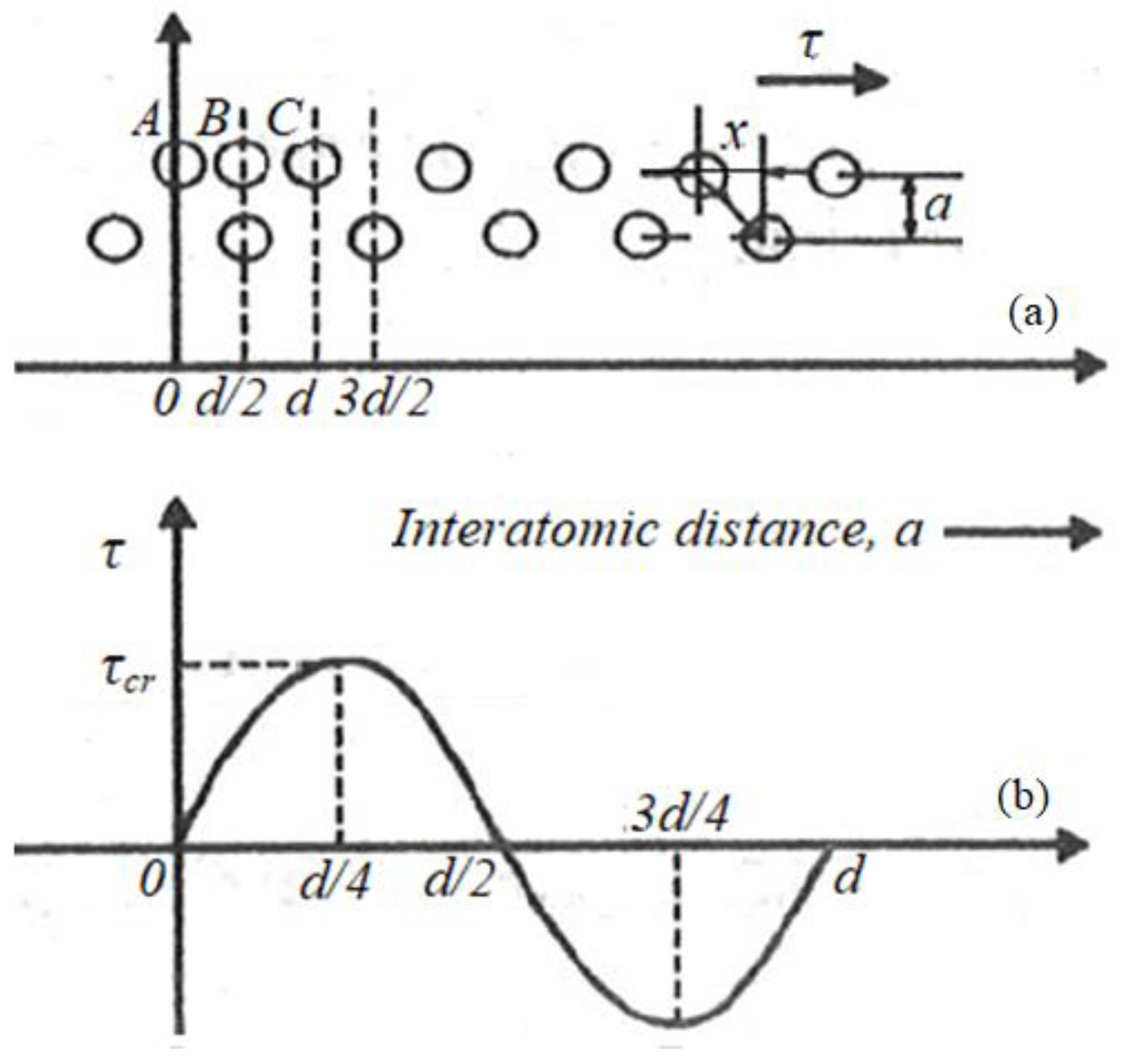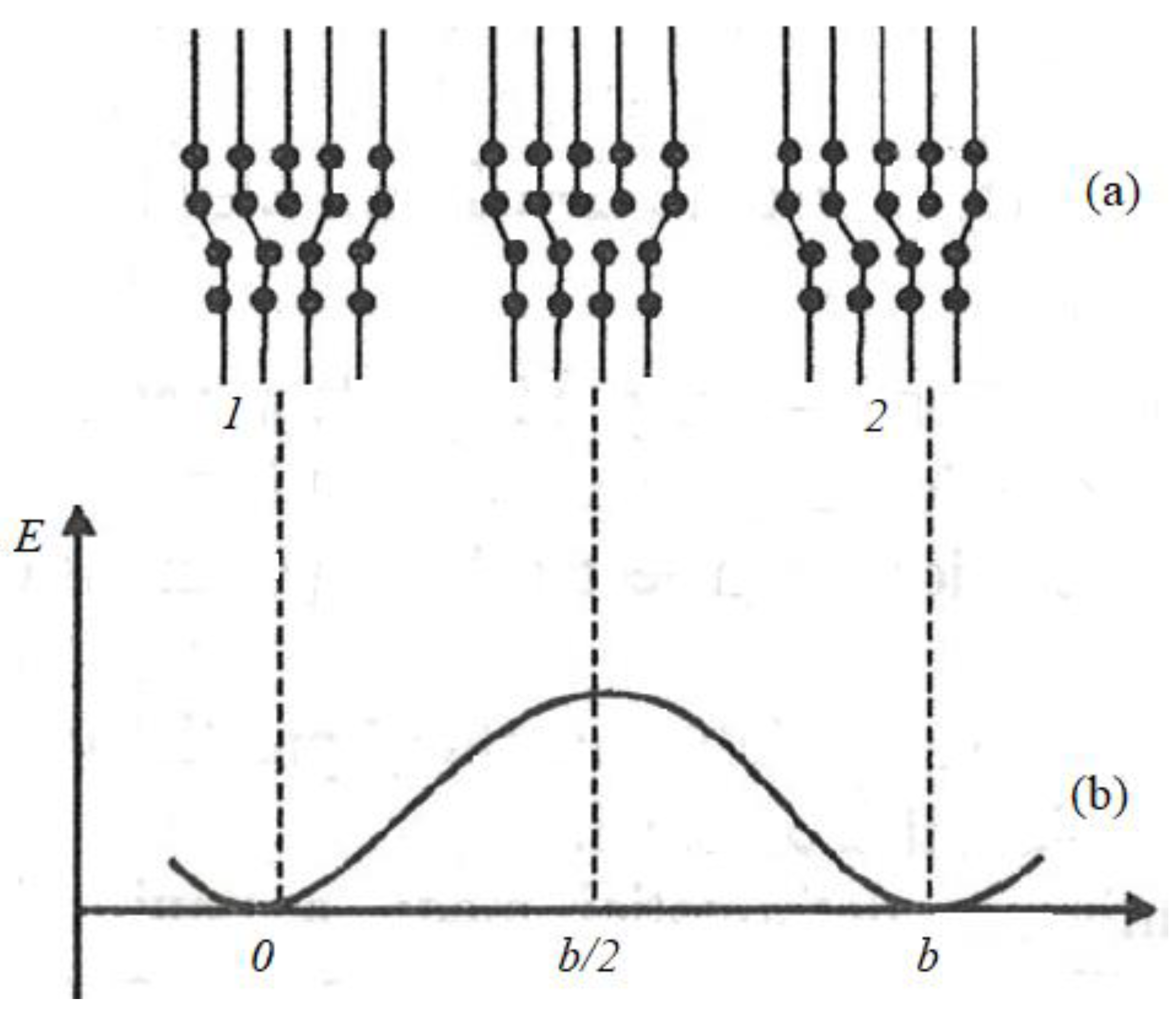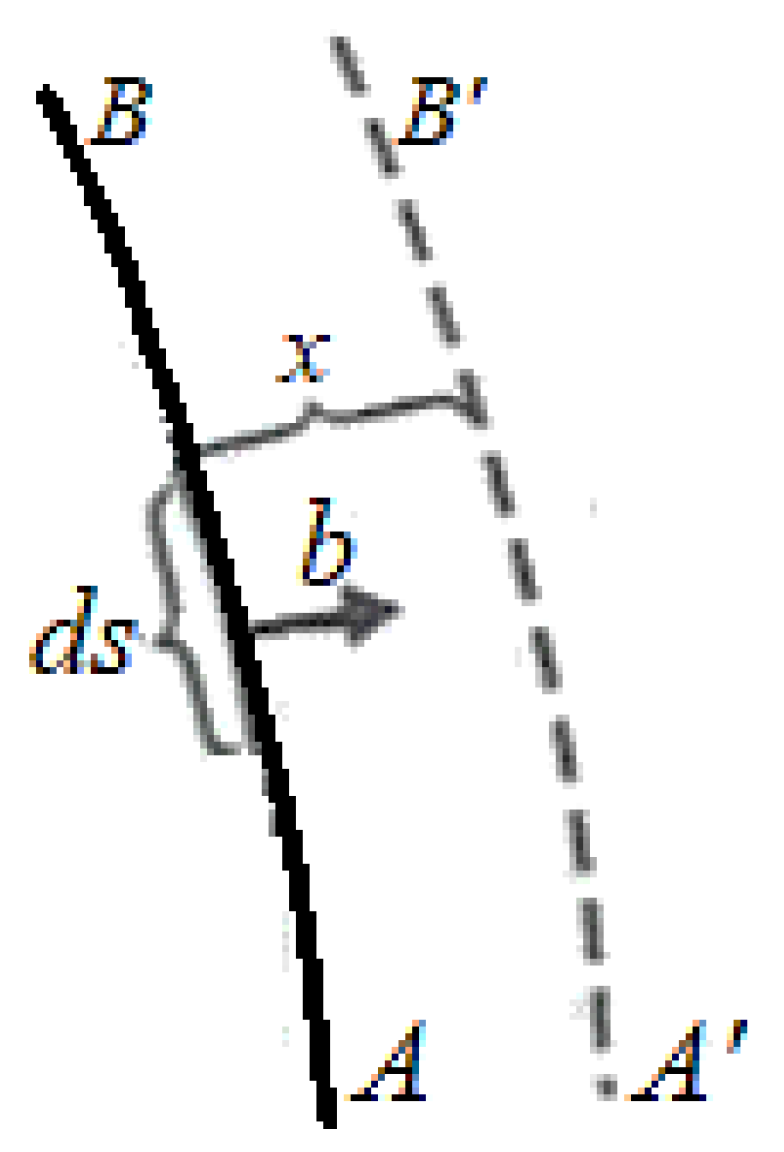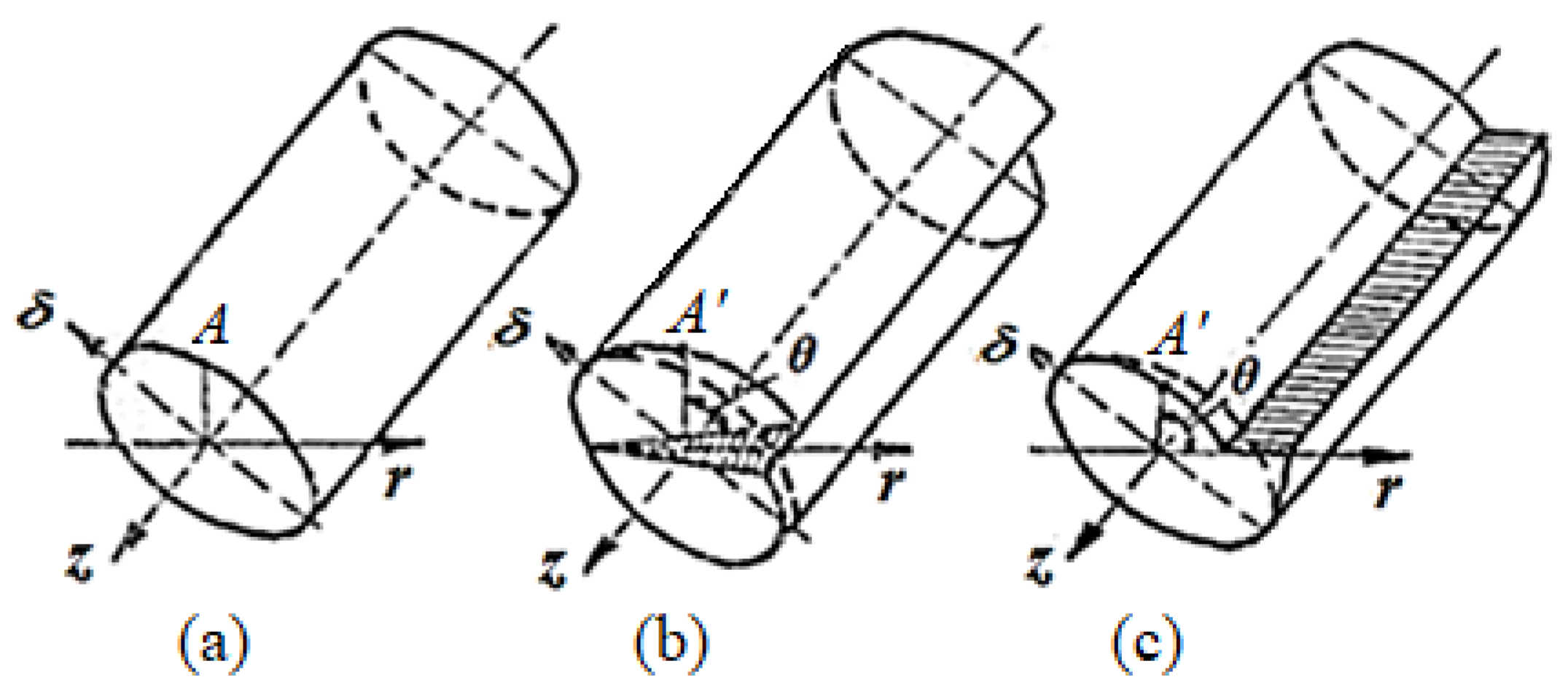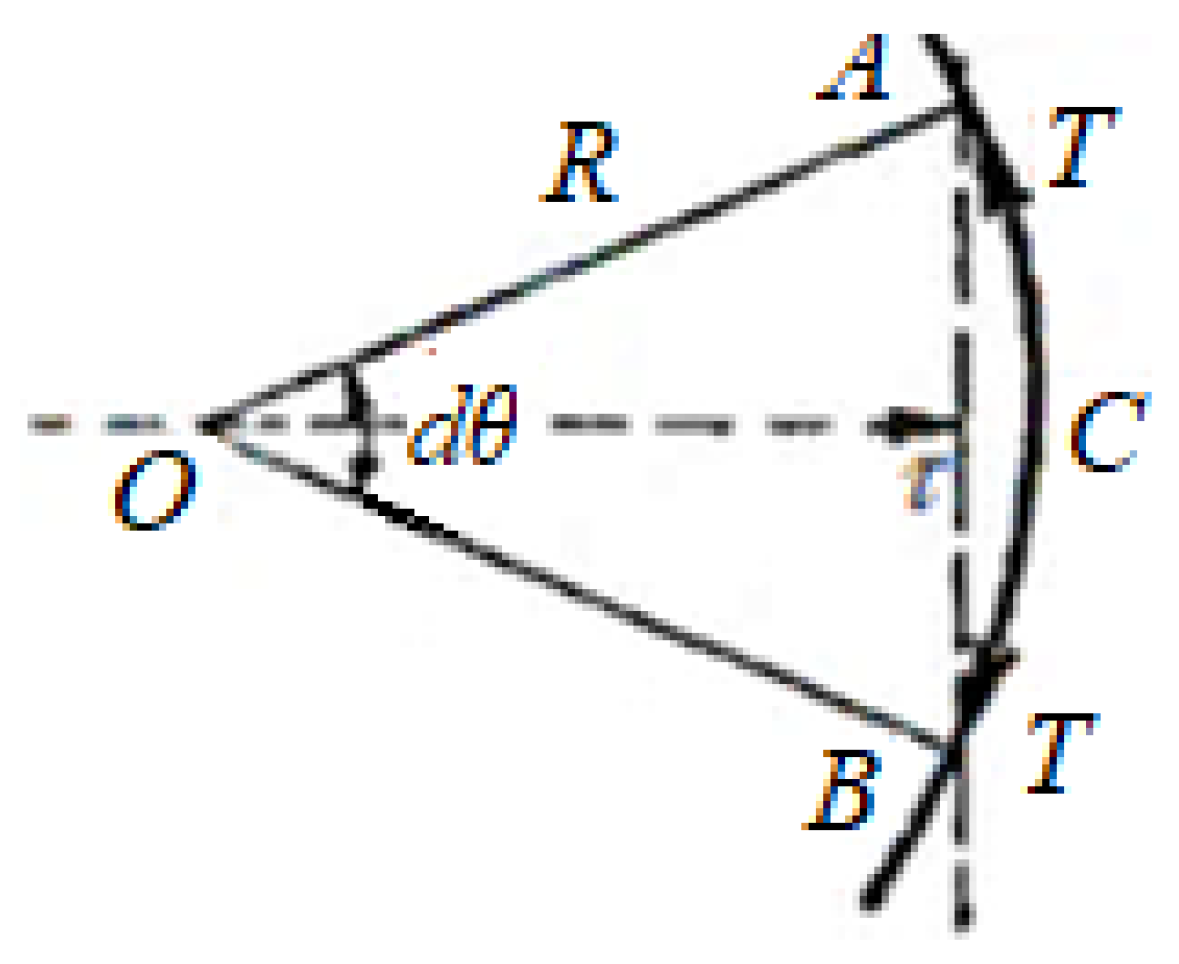1. Introduction
During the friction process of two materials and in the presence of suitable lubricants, the wear process is manifested as a transfer of material from one element of a friction pair to another (forming a selective layer), a specific process known as the selective transfer phenomenon (STP). This phenomenon lasts until the transferred (tribologically performing) layer reaches an optimal thickness, after which, it may return, totally or partially, to the initial element (repeating alternately). STP will occur in a friction pair if there is one copper-based alloy element in the pair, favorable energy, relative movement, and an adequate lubricant.
The analysis of the STP on the basis of the movement of the dislocations is useful because in the friction process of two elements a tensions and energy field is created around dislocations, which generates forces leading to their detachment, displacement, separation, and anchoring on the contact surfaces. In addition, the layer formed by selective transfer also has the property of ensuring an agglomeration of structural defects (dislocations) which protects it from destruction during the deformation process.
In the process of operation of a friction pair, the friction of adhesion layers and the metal contact interactions depend to a large extent on the state of the friction surfaces [
1,
2]. During sliding, besides oxidation as a determinant element of the process, there are other processes which favor the dynamics of the phenomenon, namely the formation of a double electric layer on the actual surface; concentration of the superficial dislocations and reduction of the tangential stresses in the surface areas; depolarization and destruction of the oxide layers, having as an effect the acceleration of the corrosion processes; electron emission in the oxide-free areas and once with the variation of the sense of the sliding speed, the formation of metal-organic compounds, of colloids and active substances, which have the effect the transporting metal particles into the contact area.
The parameters with the greatest influence on layer formation with optimal friction and wear properties are the pressure, speed, temperature, and duration of contact [
3,
4,
5].
Phenomenologically, the selective transfer assumes:
A reduction in the contact pressure as a result of the increased friction surface;
A compensation of tangential tensions by selectively dissolving the thin, superficial layer formed by the two materials in contact;
A return of the particles removed by wear into the friction area and formation of a polymerized protective layer.
During the ordinary plastic deformation of a crystalline network, two processes take place: solidification of the crystals and movement (deformation) of the plastic areas, respectively. The solidification is related especially to an interaction of the dislocations, which remain in the crystal lattice and the plastic deformation is related to a modification of the linear defects (dislocations), that come out of the surface through various sliding mechanisms [
6,
7,
8]. The sliding process by which plastic deformation is performed occurs on defined crystallographic planes and in precise directions. The way the sliding process and sliding steps formation take place can be seen in
Figure 1a.
In [
10,
11] it was shown that for metallic monocrystals with known orientation the crystallographic planes on which the slip is produced are usually flat, with a maximum atomic density and a maximum interplanes distance, and in the sliding plane, the sliding always occurs in a direction of maximum packing; the combination between a sliding plane and a sliding direction, from that plane, forms a sliding system; in a certain crystalline grain, this first occurs on that sliding system in which the tangential component of the tension (TCT) in the sliding direction has a maximum value [
10,
11]. Therefore, slipping into a crystalline grain or a mono-crystal is provoked not by all the applied tension, but only by the TCT in the direction of slipping (
Figure 1b).
This paper analyzes the structure of the superficial selective protective layer (which behaves very well during rubbing and wear) formed during the friction process, by material transfer, specific to the STP. Due to the movement of dislocations in this thin, tribologically performing layer, obtained under special conditions, it turns out that, the deformation processes ensure an agglomeration of dislocations (structural defects) which protects it from destruction.
Hence, the aim of this paper is the analysis of the STP in correlation with dislocations theory, based on the movement of the dislocations that is useful and has importance, because in the friction process and under selective transfer conditions, a tensions, energy and linear tension field is created around dislocations, which generates the forces necessary for their detachment, displacement, and anchoring, on contact surfaces, where the selective layer (already formed) is present, protecting it against destruction. Determination by modeling and knowledge of the tensions field, energy, and linear tension of the dislocations, are necessary, because the tensions field components’ size depends on the movement of the dislocations, having as an effect the maintenance of friction and wear of the friction pairs within reduced limits, by self-regulation of the phenomena and the equilibrium processes, disturbed during the friction process.
2. Establishing the Tangential Component of the Sliding Stress/Tension (TCT) and of Methodology
The TCT can be determined mathematically, if a monocrystal of cylindrical form (
Figure 1b), with base
S, subjected to the traction of an axial force
F, is considered, namely:
The value of the trigonometric factor, cosα∙cosλ in relation (1) depends on the orientation of the force in relation to the plane and the direction of the crystal sliding. This trigonometric factor may have a maximum value, which is 1/2 for α = λ = π/4, and a minimum value, which is zero if the angle α is known (from
Figure 1b) and λ = π/2, respectively.
In accordance with [
10], experimentally it was found that sliding in a crystal occurs on a sliding system when the TCT reaches a critical value in that system, called the critical sliding component or shear stress,
τ. The presence of a softer protection layer on the friction surface, relative to the base material, is a necessary condition for conducting a selective transfer by friction. In this way, it intervenes to create a positive gradient of the shear stress in the friction surface area of the two metallic materials (here bronze/steel or brass/steel, etc.) [
12]. During the friction process of the copper alloys what takes place, primarily, is a redistribution of the alloying elements that determines the behavior of the metal in the contact area. The results of the analysis of structural changes in the thin superficial layers prove that a selective transfer is characterized by certain structural changes. These structural changes represent a necessary condition, for the friction process, almost without wear. This condition supposes the formation on the friction surface of a layer of pure copper with special properties, such as a high density of dislocations and a high degree of saturation of point defects. For this reason, it was considered useful to study the selective transfer through dislocations movement.
As shown in [
9], at the beginning of the friction tests, dislocations slip in a relatively disordered way on those planes where the smallest shear stress appears. Such sliding is related to the absence of obstacles for the movement of the dislocations, which are, in fact, agglomerations of dislocations. In addition, as the trial duration and external load increase, dislocations slippage takes place in the network, whereby a state of tension is created. As the frictional stress continues, the stage of so-called dynamic restoration [
13] in other slipping planes, followed by the removal of defects with signs to the contrary occurs [
14].
As a consequence of the agglomeration of dislocation actions, a stress that exceeds the theoretical shear resistance can appear in their upper part, which is precisely
τ [
15].
During the selective transfer process in the areas of the friction surfaces, the formation of a superficial layer based on copper can lead to a decrease in the effective shear tension in the base material, and thereby, the agglomeration processes are reduced. A reduction in tangential stress can then prove insufficient to overcome the interaction forces.
As a result, there is the possibility of the formation of branched dislocations, both at the layer surface and between the layer and the base material, which make it difficult for the output of the dislocations, directly to the surface and lead to an increase in the stresses, in the material below this layer [
3,
16,
17].
Therefore, as a result an energy accumulation occurs to a significant extent in the areas close to the surface. This ensures a state, which lasts relatively long, with particularly low wear of a bronze/steel friction pair [
18,
19].
In other words, it is to be expected that the selective layer that has been transferred between the two friction surfaces will reduce the wear because the dislocations in this layer are rejected by the limit surface of the phases [
9,
20,
21,
22,
23].
From experimental research [
2,
3,
24,
25,
26] it was found that this phenomenon does not appear, for situations where the thickness of the layer can be compared to the tension field radius of action. For this reason, defects cannot be blocked because they are favored by the thermal energy generated during friction, an energy that is comparable to the energy of activation of the movement of the dislocations.
5. The Stresses/Tensions Field of a Dislocation
Any dislocation is surrounded by a tensions field that generates forces that produce the displacement of the dislocations. This field can be produced by the application of some external tensions or the existence of defects of the crystal lattice, such as dissolved foreign atoms, precipitated secondary phase particles, and other dislocations [
24,
26,
32]. The components of this field can be determined with help by the elasticity theory, but only from a distance
ρ0 from the core of the dislocation because, in the immediate vicinity of the core of dislocation, deformation is too large to be treated with the elasticity theory (
ρ0 is the dislocation core radius). The way how to form a dislocation is shown in
Figure 7. To establish the components of the tension caused by a dislocation a cylindrical body is considered, which has an axis parallel to the
z-axis (
Figure 7a).
In this body we introduce a dislocation and proceed according to the following imaginary mechanism:
the body is radially cut down the plane δ = 0 to the point where the dislocation will be located (possibly up to the point r = 0, δ = 0);
a force moving the surfaces obtained by cutting one above the other with the distance b/2 (b being the size of the Burgers vector) is applied so that the total displacement is b;
the two surfaces are brought together, by cutting.
If the driving force produced a displacement
b parallel to the
z-axis, the dislocation obtained is a helical one (
Figure 7b), and if the displacement
b is perpendicular to the
z-axis, the dislocation is linear (
Figure 7c). The components of the tensions field produced by a helical dislocation can be determined with the notations in
Figure 7b. If prior to displacement, the point
A (see
Figure 7a) has the coordinates
x,
y,
z, these deformations become
r +
u,
δ +
v, and
z +
w (see
Figure 7b), where
u,
v, and
w are the displacements of the point
A along with the
r,
δ,
z-axes.
It is noted that:
where
θ the angle formed by the
r-axis with the right that joins point
A with the origin of the coordinate system,
u represents the displacement along the
r-axis;
v is the displacement along the
δ-axis;
w is the displacement along the
z-axis. Hence, the deformation specific components, after the
r,
δ,
z directions, can be written as [
28,
29,
30]:
where
ρ is the radius of the cylindrical area centered on the dislocation line, to the point where the tension is calculated, and the angular deformations are [
29,
31]:
Based on the relations (8) and (9), since
u =
v = 0, for a helical dislocation oriented in the
z-direction (see
Figure 7b), the tensions field has a component single and can be expressed in cylindrical coordinates, according to the notations from
Figure 5, in the form:
The tensions field according to (9) and (10) has only one component of tension, non-zero, τδz from the relation (11). Therefore, in the case of helical dislocations, there are no normal tensions but only tangential tensions, the tensions field being symmetrical.
When the tensions field around linear dislocations is asymmetrical in the sense that the plane of sliding divides the crystal into two halves; in the half containing the additional half-plane (see
Figure 3a) the tensions are of compression, in the other half the tensions are of tensile (stretching).
For the determination of the tensions field of a linear displacement, is consider
Figure 7c, from which results in the linear displacement components in the system of cylindrical coordinates:
Considering the relations (10), the following expressions are obtained for the components of the tension in cylindrical coordinates:
where
G represents the transverse elastic modulus;
vp is the Poisson coefficient;
b is the size of Burgers dislocation vector and
ρ is the radius of the cylindrical area centered on the dislocation line, to the point where the tension is calculated.
7. Results and Discussion
It was seen that, on a dislocation that is in a tensions field, forces act that cause its movement. The tensions field can be external, internal, or combined, having the same effect on dislocation.
It is understandable based on the above (
Section 4) that in the case of the internal tensions field the dislocations displacement occurs on account of the reduction of the elastic energy of the field, and a modify of these tensions takes place.
The parameters of the crystalline structure of the analyzed and researched bronzes are confused with those of copper, because it is the dominant chemical element (>85%), and are: ρ0 = 3 × 10−10 m, ρ = 10−6 m, b = 2.5 × 10−10 m, G2 = 4 × 1010 N/m2, νp = 0.33, s = 2.526 × 10−10 m, L = 2.5 × 10−10 m, α = 70°32′, the energy on the dislocation length is approximately 0.25 J/m, and for comparison will be presented G1 = 8 × 1010 N/m2, for steel.
Thus, for a steel/bronze pair lubricated with glycerin, the dislocations formed in the steel and during start-up will always be attracted by the phase boundary surface, as G1 is considerably larger than G2 (G1 >>> G2, see the values above), for which the surface layer will solidify on the steel element. At the same time, more surface layers will solidify on the bronze element than on the steel element, because the dislocations formed in the layer near the surface are rejected from the separation surface.
The copper layer formed under the selective-transfer conditions alters the conditions for the interaction of the surface areas as well as of dislocations, in the separation layer of the surfaces. Under these conditions, the dislocations produced in the steel are attracted by the separation surface, because G1 > G2. For bronze, the condition G1 < G2 is valid if it can be assumed that the copper layer possess a solid crystal lattice. In this case, the areas near the friction surface of the bronze element will be modified, as the dislocations are rejected from the surface.
Taking into account the results of the research on the structure of the copper layer under selective-transfer conditions [
3,
33,
34], where a layer softening is found during the friction process, then the adhesion at the areas of surface must be weaker. As a result, there is an accumulation of elastic energy in areas close to the surface. This ensures a condition, that lasts relatively long, leading to a particularly low wear of the friction pair.
Therefore, at the contact the two materials (bronze/steel) with the shear modules (transverse resistance modules) G1 (for base material, steel) and G2 (for the selective layer, bronze), the dislocations in steel with module G1 are displaced at the boundary of the two surfaces in contact, then condition G1 > G2 is met; and are rejected when condition G1 < G2 is valid. These conditions are also valid for the description of the interaction energy of dislocations with a surface covered with a homogeneous layer of thickness h.
Thus, if
G1 > G2, the dislocation is drawn all the time to the surface, and if
G1 <
G2, the dislocation is drawn to the surface for,
s >>
h (
s—distance from the surface at which the dislocation is located) and,
s <<
h, the dislocation is rejected from the surface [
9]. From this statement we can formulate the equilibrium condition, namely: if
G2 >
G1, then the dislocation is in equilibrium with the surface and
s ≈
h.
Now, replacing them in relation (21) one can determine the density of dislocations, d for the bronze/steel pair, which works in the conditions of selective transfer and is obtained: d = 2.483 × 1014 dislocations/m2, T = 2.42 × 10−9 N, Fd = 1.56 N/m, and τ = 6.24 × 103 MPa. By comparing the value of the calculated mixed dislocation density (2.483 × 1014 dislocations/m2) with the value obtained experimentally by ferromagnetic resonance which is 2.55 × 1014 dislocations/m2 we can confirm the correlation between the results obtained analytically and the experimental ones. Thus, it was proved that there is a correlation between theory and experiment; the results from experiments are validated by modeling, based on elasticity theory, but only from a distance very small from the core of the dislocation, using the model of a cylindrical body having an axis parallel with a direction of the tension field. At the same time, it is demonstrated that for the friction pairs that operate in the conditions of selective transfer, the specific dislocations are the mixed ones.
8. Conclusions
At the contact of two materials with the shear modules different (here bronze/steel) G1 (for steel—the base material) and G2 (for bronze—the selective layer), the dislocations can be found in the following situations:
the dislocations in the material with the G1 module are drawn to the limit of the two surfaces in contact when the condition G1 > G2 is satisfied;
the dislocations in the material with the G1 module are rejected when the condition G1 < G2 is valid.
These conditions are valid to the description of the energy of interaction of the dislocations with a covered surface with a homogeneous layer of thickness h. Hence, when the condition G1 < G2 is satisfied, the dislocation is drawn to the surface for, s >> h, and this is rejected from the surface for, s << h, and if G2 > G1, then the dislocation is in equilibrium with the surface and s ≈ h.
Because G1 >>> G2, at the contact of bronze/steel pair lubricated with glycerin, the dislocations formed in the steel, even at the startup will always be attracted to the limit surface of the phases, i.e., a superficial layer will adhere on the steel element. At the same time on the bronze element a superficial selective layer will adhere more than on the steel element, because the dislocations formed in the layer near the surface are rejected from separation surface.
In the selective-transfer conditions a copper layer formed, which alters the conditions for the interaction of superficial areas of the surfaces, as well as of dislocations, in the separation layer of the surfaces.
Based on the results of the research on the structure of the copper layer under the selective-transfer conditions, a soaking of the layer during the friction process is found, hence, the adhesion at the areas of surface must be more reduced. As a result, an accumulation of elastic energy takes place in the areas close to the surface, which assures a state which lasts relatively long and leads to particularly low wear of the friction pair.
To prove these affirmations, it was necessary to determine the density of dislocations in the superficial areas, which is very difficult but by using ferromagnetic resonance, this is possible. This assumes the determination of ferromagnetic resonance lines at a certain frequency. Through measuring the width of the ferromagnetic lines, the dislocations density can be estimated, because ferromagnetic line widening contributes to both the dislocations and the asperities of the surface.
During a selective-transfer, use of a tension-active lubricant (glycerin) results in a dislocation density of 2.55 × 1010 dislocations/cm2, which is very close to the one determined through the analytical calculations (2.483 × 1010 dislocations/cm2), and under the usual friction conditions, the density of the dislocations is of 7.7 × 1010 dislocations/cm2. The result proves that the structure of the dislocations changes very little during a selective transfer, which ensures a very small wear condition, as well as a reduced friction coefficient in the contact surfaces area.
The analysis of the STP in correlation with dislocations theory is useful and has importance, because in the friction process and under selective transfer conditions a tensions field is created, around dislocations, the energy and the linear tension, which generates forces necessary for their detachment, displacement and anchoring, on the contact surfaces, where the selective layer (already formed) is present, protecting it from destruction.
The analysis of the STP based on dislocations movement allowed us to establish and know the tensions field influence, the energy (about 0.25 J/m), and the linear tension of dislocations (~2.42 × 10−9 N) in the contact surfaces zone of a friction pair, which ensures a low wear state (~4.16 × 10−5–2.16 × 10−4 g/min) and a reduced friction coefficient (~0.014–0.034), respectively. Hence, it was proved that there is a correlation between theory and experiment and the results from experiments are validated by modeling.
The existence, importance, and utility of the dislocations and their movement in the conditions selective transfer, respectively, at the limit of the friction surfaces under the action of a tensions field was proved.
The layer formed through STP has the property of ensuring in the deformation process an agglomeration of structural defects which protects it against destruction, thus is assuring the self-regulation of the equilibrium processes, disturbed in the friction process, with the aim to maintain the friction and wear of the friction pairs within reduced limits.
Therefore, knowing the tensions field, energy, and linear tension of the dislocations, in the conditions of selective transfer is important and useful for complexity analysis of the STP and the practical results for the operation of friction pairs with low wear, respectively, and reduced friction coefficients.

